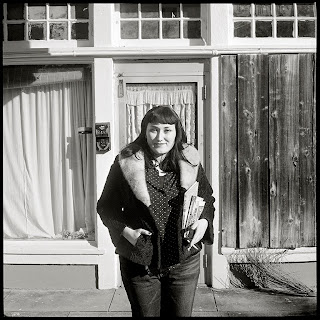
Bill Matthews, Preservation Hall
1964, oil on canvas
If you've spent any amount of time, as I have, in conversation with the old-line bohemians of the French Quarter, you've heard many tales of the late Noel Rockmore. He was a regular patron of the lower-Quarter artist's cafes and bars central to that social scene, and he held court with no less intrigue and charisma than his fellow bohemian, Tennessee Williams. Arriving in "the last frontier of Bohemia" in 1959, Rockmore discovered the place of his dreams, a place that allowed him to both portray the fantasy and decay so central to his personal aesthetic, and to do so by painting what was there, without embellishment.
Born in New York City in 1928, he had both lived in France and studied violin by the age of five. He and his sister, Deborah studied briefly at Julliard. By 1939, painting and art had become his passion. By 16, he was copying Rembrandt at the Metropolitan Museum. By 18, he was studying at the Art Students League.
In 1948, Joseph Hirshhorn purchased Rockmore's Self-Portrait with a Model. At the same time, his style was being defined through a series of seventy-five drawings of Bowery bums. He depicted these crushing figures without social comment, a style he continued throughout his career. He spent time in the Natural History Museum painting monkeys and mummies. Several years were spent depicting Coney Island through drawings, etchings and paintings.
In 1951, Rockmore married and honeymooned in Mexico. During the trip, his car hit a cow, and much to the dismay of his bride, rather than seeking help, he spent time sketching the dying bovine. This obsession with death and decay continued in his next major series of three hundred circus paintings and drawings. For several weeks he travelled with the circus, and found himself overwhelmed with the thundering throngs of humans and animals, all in various states of decline.
Throughout the fifties, his work matured and continued to meet growing critical success. The Whitney Museum exhibited his work in 1956. In 1958, Hirshhorn bought nine more paintings, all of which are now in the Hirshhorn Museum in Washington, D.C.

Billie and DeDe Pierce, Preservation Hall
Oil on canvas, 1963.
A friend recommended that Rockmore visit New Orleans in 1959, and arranged a studio for him in the home of Paul Ninas. By 1963, Rockmore had executed over 350 portraits of musicians at Preservation Hall. Ben Jaffe, bassist, creative director and proprietor heir of Preservation Hall, told me recently that his father would often purchase the portraits painted in Preservation Hall. It was a kind of steady income for Rockmore during his early years in New Orleans.
The Ogden Museum is proud to have five portraits from the Preservation Hall series in its collection, all gifts from the Roger H. Ogden Collection. The two works pictured above are currently exhibited on the fourth floor of Goldring Hall.














,+McLean,+Texas,+July+2004_.jpg)














.jpg)
.jpg)
.jpg)
.JPG)
.JPG)
.jpg)

















